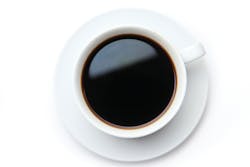Back in January of 2011, VendingMarketWatch reported that coffee prices in the U.S. had reached their highest level in thirteen years. Those 2011 prices encouraged producers to invest in and expand production. Now, three years later, the U.S. Department of Agriculture is reporting a coffee surplus. Global coffee production is expected to exceed demand for the fourth consecutive season.
Price margins increase
The International Coffee Organization noted that 2013 recorded the lowest average annual price in coffee since 2009, with a composite indicator of 119.51 U.S. cents per pound, driven by a surplus of production over consumption. The cost of coffee was down nearly 20 percent in 2013 and has fallen 49 percent since 2011, according to the Wall Street Journal.
Despite the decrease, coffee companies have kept the prices steady or even raised them for consumers, creating better profit margins. Earlier in 2013, Starbucks raised its prices about 1 percent nationwide. This has also been the case in the OCS business. According to Automatic Merchandiser’s 2013 State of the Coffee Industry report 88.2 percent of OCS operators raised their prices from 2010 to 2011. The next year, half the operators raised prices while 43.3 percent made no change due to previously raising prices to a profitable level. Steve Brehm, president of Berry Coffee Co. explains that the decline in coffee prices has allowed many OCS operators to regain lost margins that were difficult to pass on to consumers in the past.
Quality cup of joe for less
The surplus has also affected gourmet coffee as the difference in prices between arabica and robusta beans has dropped. In January 2013, the arabica bean sold for 158.27 U.S. cents per pound and dropped to 126.74 U.S. cents per pound by December 2013. The price differential between the two narrowed to $.31 with robusta selling for 95.5 U.S. cents per pound in December 2013. Because of this decline, more roasters began using arabica beans in coffee blends and offering a higher-quality cup of coffee for less. Traditionally, the arabica bean is favored by high-end roasters due to its milder flavor. “The quality of coffee now available to the trade is as good as it has been in years, which allows us to provide an excellent cup of coffee to the consumer at a price that fits their budget,” said Brehm.
For 2013/2014, coffee prices show little sign of rebounding without weather or crop complications. The U.S. Department of Agriculture has projected that coffee stocks in producing countries will continue to rise. At the same time, the demand from consuming countries — such as the U.S. — will remain flat, lowering prices even more. Long-term, this might not be good for the OCS industry. Discover more on the future of coffee prices on VendingMarketWatchTV.
About the Author

Adrienne Klein
Contributing Editor
Adrienne Zimmer Klein is a freelance writer with a background in the vending, micro market and office coffee service industry. She worked as an associate editor and managing editor at Automatic Merchandiser and VendingMarketWatch.com from 2013 until 2017. She is a regular contributing writer at Automatic Merchandiser.
